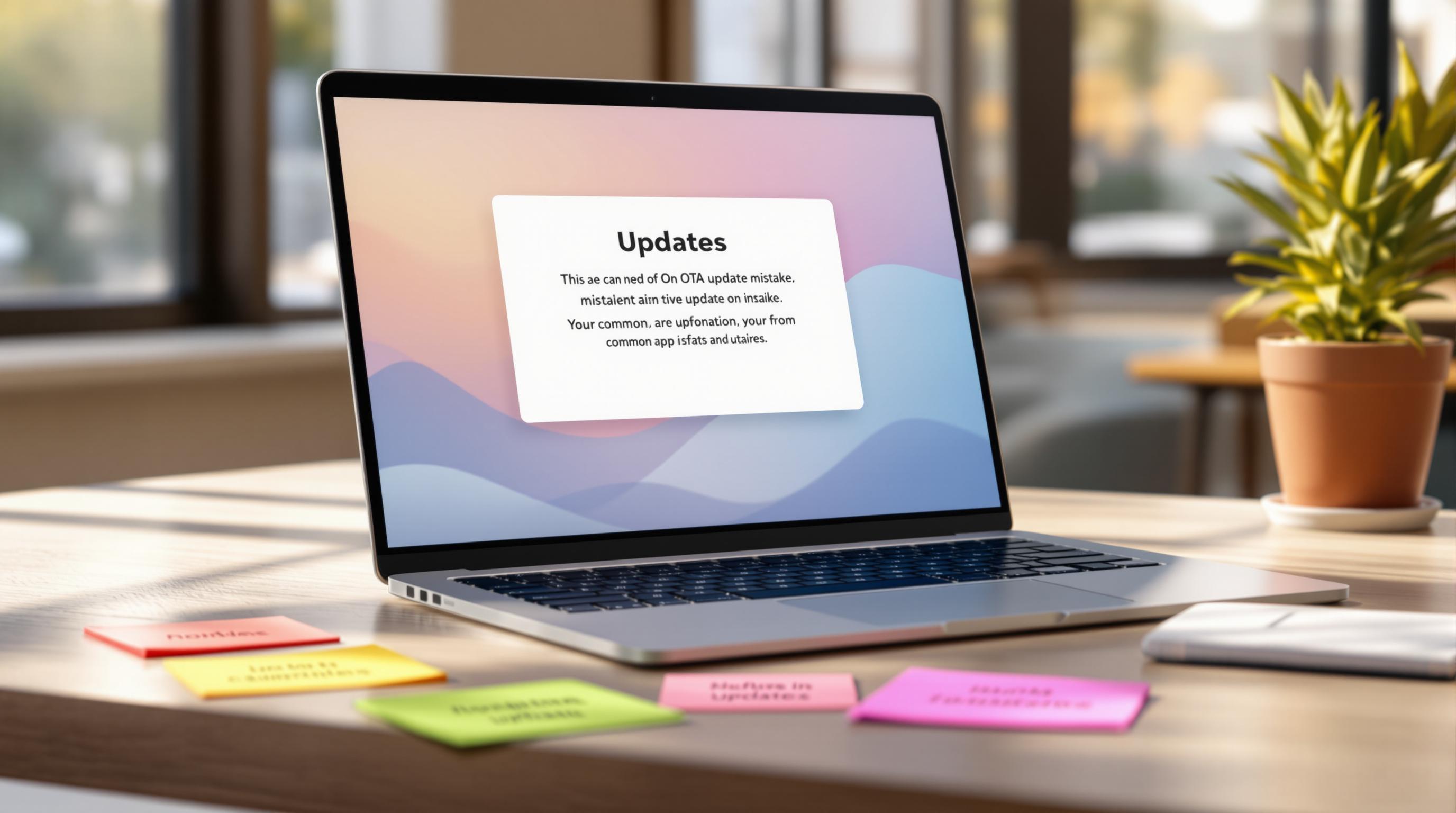Keeping your mobile app secure during live updates is critical to protecting user data and maintaining trust. Here’s a quick summary of the top practices to safeguard your over-the-air (OTA) updates:
-
Secure Delivery: Use encryption (e.g., TLS), digital signatures, and multi-factor authentication to protect updates during transmission.
-
Data Integrity: Validate updates with checksums, package signature verification, and version control to prevent tampering.
-
Block Unauthorized Access: Implement role-based access control (RBAC), multi-layer authentication, and encrypted communication to restrict access.
-
Regular Updates and Patches: Quickly address vulnerabilities with automated update tools and keep third-party dependencies up to date.
-
Thorough Security Testing: Use automated tools like OWASP ZAP and manual testing to catch vulnerabilities before updates are deployed.
Why It Matters
By following these practices, you can reduce security risks, comply with regulations like GDPR and HIPAA, and maintain user confidence. Tools like Capgo and secure CI/CD pipelines can help streamline these processes while ensuring updates remain safe.
Let’s dive deeper into each practice to understand how they protect your app and users.
How to win with OTA updates
1. Secure Delivery of Updates
To ensure safe updates for Capacitor-based apps, encryption and authentication protocols are the backbone of a secure delivery pipeline.
“Secure coding is the foundation of security for mobile applications” [1].
Here are some key measures to keep your updates secure:
| Security Measure | Implementation | Purpose |
|---|---|---|
| Transport Layer Security | HTTPS/SSL/TLS protocols | Encrypt data during transmission |
| Package Verification | Digital signatures | Confirm the authenticity of updates |
| Access Management | Multi-factor authentication | Restrict update deployment access |
| Integrity Validation | Automated checksums | Detect and prevent tampering |
Authentication and Access Control
Using tools like Capgo, encryption and role-based access control ensure only authorized personnel can manage updates. This layer of security minimizes risks from unauthorized changes or breaches.
Version Control and Integrity Checks
Automated integrity checks are essential for verifying that updates are genuine and untampered. This step protects users from malicious packages.
CI/CD Pipeline Security
Incorporating security into the entire CI/CD pipeline is non-negotiable. Here’s how you can do it:
-
Secure coding practices during development
-
Automated tools to scan for vulnerabilities
-
Regular audits of the update delivery process
-
Detailed logging of all update-related activities
These practices not only secure updates but also maintain the efficiency of deployment. For industries bound by regulations like HIPAA or GDPR, strict adherence to these measures is mandatory.
Finally, while securing the pipeline is crucial, verifying the integrity of the updates themselves ensures malicious code never reaches your users.
2. Ensure Data Integrity and Validation
Maintaining data integrity is crucial for live updates. If data is compromised, it can lead to security risks and erode user trust. To avoid this, strong validation processes work hand-in-hand with encryption to ensure updates are secure and reliable.
How Data Integrity Is Protected
Update systems use multiple layers of security to safeguard data during transmission. These include encryption, digital signatures, and automated checks to ensure updates remain intact and untampered.
Key steps for validation include:
-
Package signature verification: Ensures the update is legitimate.
-
Checksum validation: Identifies any file alterations during transit.
-
Version control checks: Stops downgrade attacks and keeps updates in the correct sequence.
Real-Time Protection with RASP
Runtime application self-protection (RASP) takes things further by providing real-time defense. It delivers threat analytics and secures critical app details, like API keys, in the cloud. This ensures apps stay protected even as threats evolve.
Automated Monitoring for Security
Automated verification processes, like real-time monitoring, add another layer of security. They flag anomalies as they happen and help maintain data quality. For instance, Netflix uses automated integrity checks in their content delivery systems to efficiently ensure data quality at scale [2].
While ensuring data integrity is essential, keeping unauthorized access at bay is just as important to prevent security breaches.
sbb-itb-f9944d2
3. Block Unauthorized Access
Unauthorized access is a major threat to OTA updates, making strong access controls a must. DashDevs emphasizes:
“Secure coding is the foundation of security for mobile applications. It involves writing code to minimize the introduction of security vulnerabilities” [1].
Multi-Layer Authentication
Using multiple authentication layers helps ensure that only verified updates are installed. This can include methods like multi-factor authentication, digital signatures, and secure token management to confirm the legitimacy of updates.
Role-Based Access Control
Role-based access control (RBAC) restricts update permissions based on user roles. For example, developers might handle testing, release managers oversee production, and security administrators manage system oversight. This limits access to only those who need it.
Secure Operations
All communications related to updates should use encrypted channels. Validate API endpoints and keep an eye on traffic for unusual activity. Automated systems can log and flag suspicious access attempts in real-time, adding an extra layer of protection.
While keeping unauthorized access at bay is crucial, don’t forget that regular updates and patches are key to maintaining a secure app.
4. Apply Regular Updates and Patches
For live OTA updates in Capacitor apps, keeping your app updated is key to addressing new risks and maintaining user confidence.
Automated Update Management
Using automated CI/CD tools makes managing updates easier and more secure. These tools help you quickly address vulnerabilities through timely patches.
Keeping Third-Party Dependencies Updated
Outdated third-party dependencies can be a hidden risk. To tackle this, ensure your update plan covers the following:
| Component | Update Frequency | Security Focus |
|---|---|---|
| Core Libraries | Monthly or as updates roll out | Check for version compatibility |
| Security Components | Immediately after patch release | Assess vulnerabilities and run regression tests |
Version Control and Rollback Plans
Good version control is essential for smooth updates. This involves running security scans to validate updates, using phased rollouts to catch issues early, and having a quick rollback or patching process for critical problems.
Regular updates are a strong line of defense, but their success depends on thorough security testing to catch and fix vulnerabilities before they reach users.
5. Conduct Thorough Security Testing
Updating your systems is essential, but it’s just as important to ensure those updates don’t create new risks. Rigorous security testing helps you catch potential issues before they affect your users.
Automated Security Testing Integration
Incorporating automated tools into your CI/CD pipelines can help catch vulnerabilities early and often. Tools like OWASP ZAP and Snyk are great for identifying risks during the update process and enabling quick fixes.
| Testing Type | Details |
|---|---|
| Vulnerability Scanning | Regular scans to catch known weaknesses |
| Penetration Testing | Simulations to mimic real-world attacks |
| Code Review | Examining source code before each update |
Manual Security Assessment
Automation is powerful, but it has its limits. Security experts can manually assess your systems to uncover more complex vulnerabilities that automated tools might miss.
Tracking Security Metrics
Keep an eye on key metrics like how quickly vulnerabilities are detected, how long it takes to fix them, and how much of your system is covered by testing. These insights can help you improve over time.
Following Industry Standards
Using frameworks like OWASP ensures your testing process is thorough and aligns with established best practices. This approach helps you uncover vulnerabilities while staying compliant with industry expectations.
Netflix is a prime example of combining automated and manual testing in their CI/CD pipeline, showing how a layered approach can strengthen security [2].
Conclusion
By following the five key practices - securing delivery, validating integrity, blocking unauthorized access, applying timely updates, and conducting thorough testing - developers can better protect their apps and users from ever-changing threats. For apps built with Capacitor, where OTA updates are critical for fast and efficient maintenance, these steps help strike the right balance between speed and security.
Strong security practices for live updates in Capacitor-based apps are essential to avoid vulnerabilities, safeguard user data, and meet industry regulations. Data breaches not only cost millions but also damage financial stability and user confidence.
Security isn’t a one-time effort. It requires regular updates, constant monitoring, and thorough testing. Combining automated tools with manual reviews creates a stronger defense, especially when integrated into CI/CD pipelines. A great example is Netflix, which uses an extensive security testing framework to stay ahead of potential risks [2].
These efforts also bring measurable improvements across several business areas:
| Impact Area | Advantage |
|---|---|
| User Trust | Builds user confidence and app reliability |
| Compliance | Meets regulations like GDPR and HIPAA |
| Risk Management | Reduces security vulnerabilities |
| Operating Costs | Cuts down expenses tied to security incidents |
For those looking to implement these strategies, tools like ProGuard for Android and secure compilation methods for iOS offer practical solutions to enhance update security. Using HTTPS protocols and encryption during update delivery ensures both the transmission process and user data remain safe.




